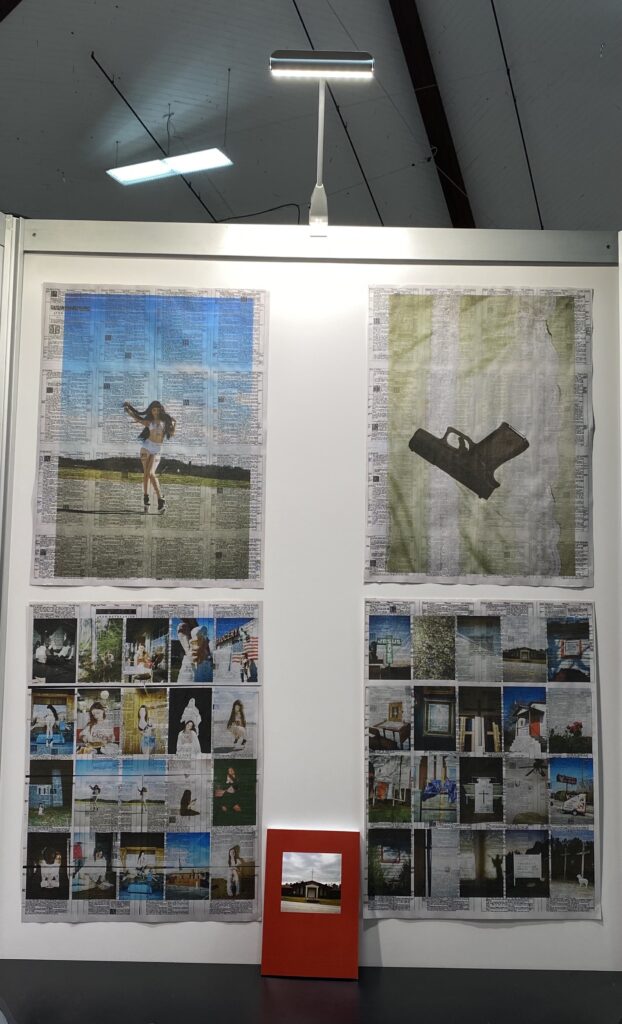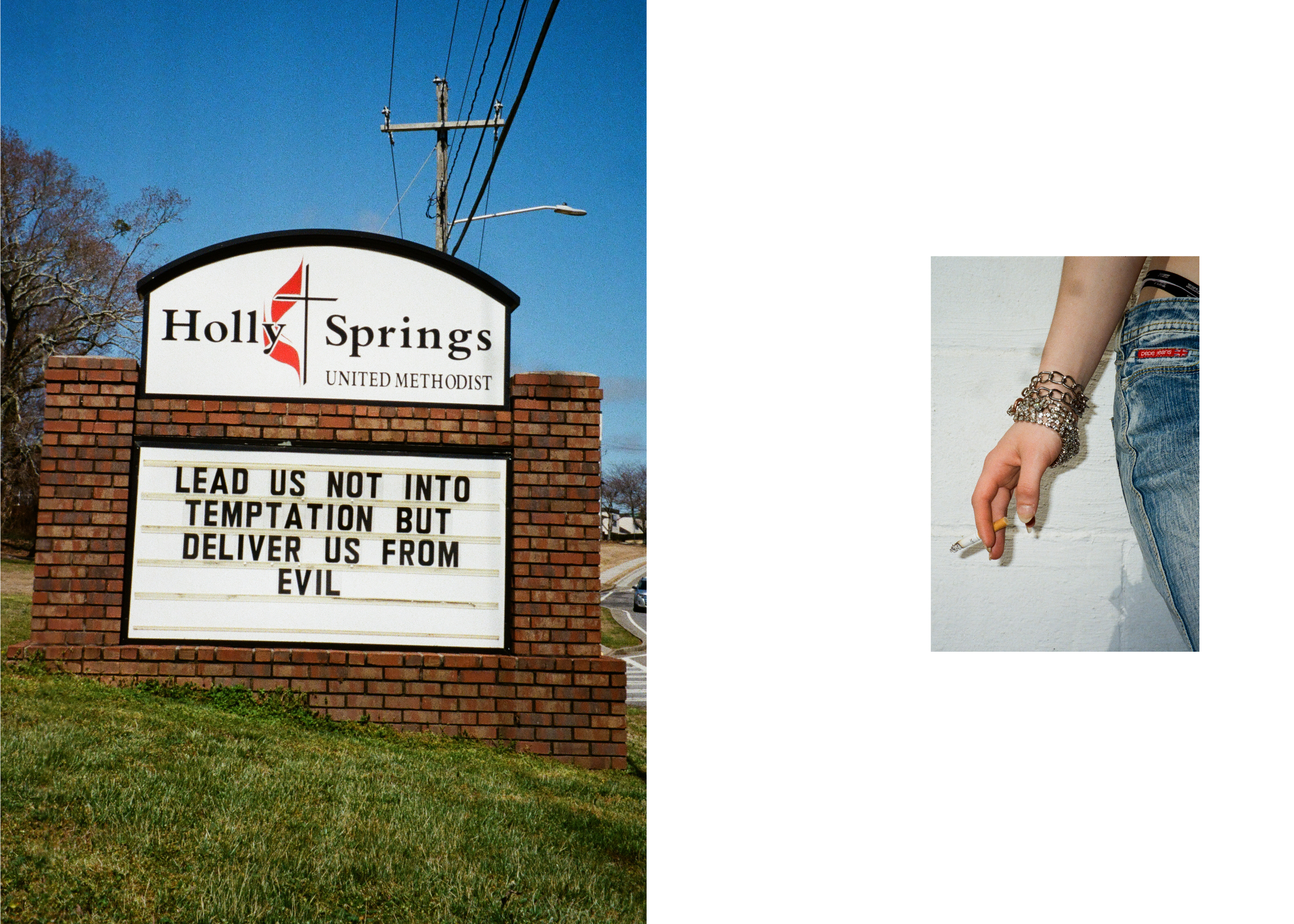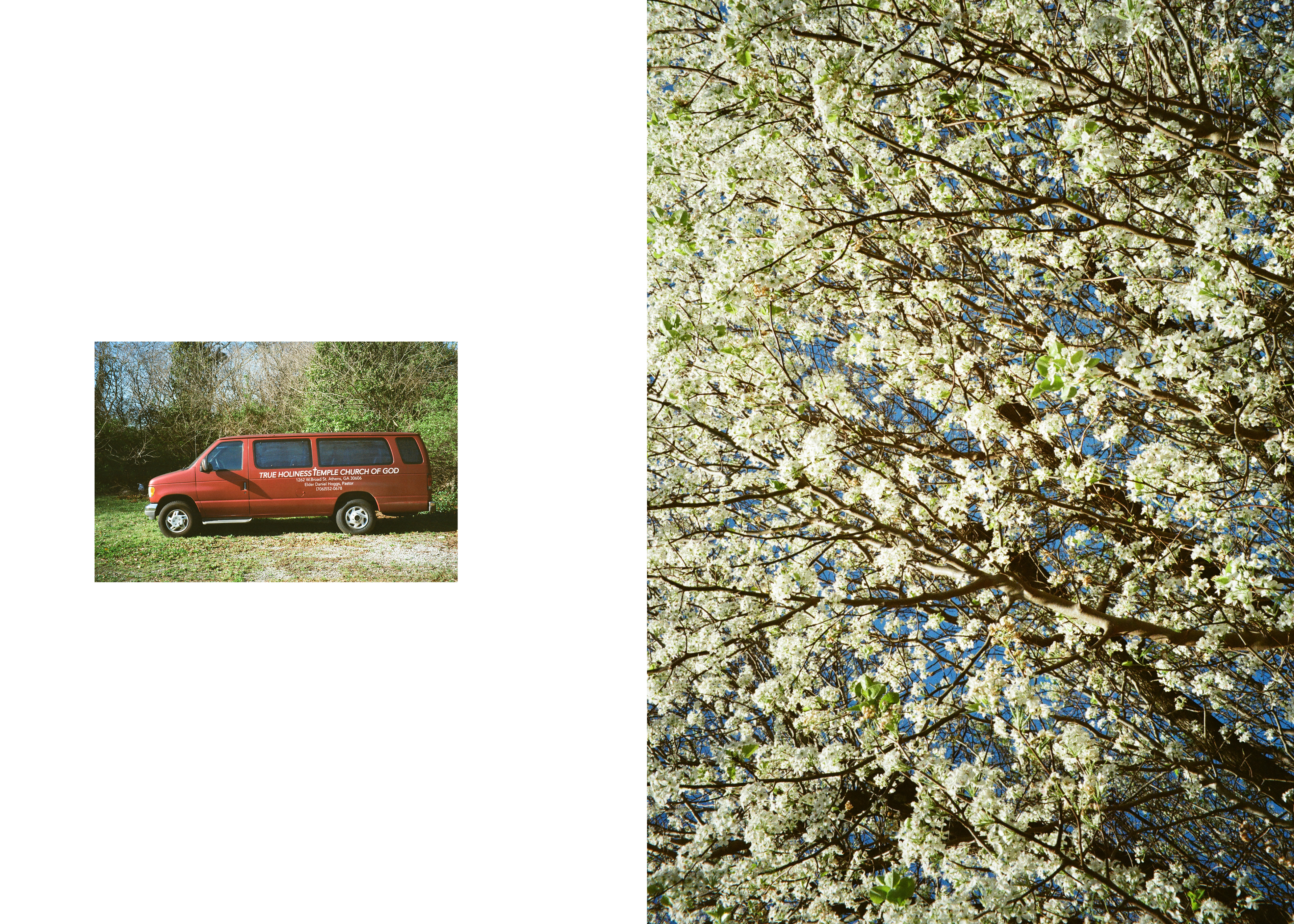Meg Bryant
Walk With God
Walk With God
Tags +
My thesis topic revolves around Christian iconography, sacred and dreamscape spaces, and southern culture. I decided to choose this topic after investigating symbolism, evangelist brands, religion as an all encompassing space, the contrast between commercial branding and religious iconography, and the spectrum of design from the philosophy of the sublime to cringe to camp to kitsch aesthetics from Fall 2021 to now. Using Christian iconography was a starting point for me because I have experience with the religion itself and its aesthetics. The sublime lends itself to religion as it's an almost spiritual experience. Last semester I also investigated kitsch design in context with Christianity. I plan to create a collection of images in the form of three 7x10 inch physical books. There will be two 35mm film photography books and one graphic book that align at their spine to form a cross. The images from my 35mm book will be shot by me. One book will be a narrative following a character around the Bible Belt, while the other will be an assorted collection of images that include various references to Christianity.
When I started exploring my thesis, my main areas of interest were centered around Christianity. As a child, I was raised by conservative Christians, and religious influence was always present. I was surrounded by religious statues, posters, and clothing. I didn’t think about it then, but I was subconsciously being exposed to Christianity in the marketplace almost every day. When exploring my thesis topic in the first semester, I became curious about spiritual opportunism, branding, religious iconography/symbolism, and sacred spaces.
Christian iconography is so pervasive that most non-religious people recognize Christian symbols regardless of religion or creed. One form of spiritual opportunism includes the use of religious imagery to sell non-church related products. “If you really want to shock people in the art world, talk about Jesus or God,” says David Lachapelle, who explores heaven, the new testament, and spiritual enlightenment in his work (Iqbal). Lachapelle’s work often reframes religious scenes from the Bible such as his “Last Supper” (from Jesus is My Homeboy) and his series American Jesus with Michael Jackson. Lachapelle plays with kitsch photography broadly. He does this using characters and subject matter like Amanda Lepore snorting diamonds and Hillary Clinton posing with her wax model. Kitsch calls for “fast and bad design” (Narter). My hunt for kitsch design last semester led me to websites like Blingee, a site that allows you to build your own animated design using premade graphics. These designs reminded me of my childhood and middle school years, and I wanted to create similar images.
Pierre Gilles is another artist who uses overdone aesthetics to create photos both reflective of editorial campaigns and paying homage to pop art in a new way. He mixes pop-culture and religious iconography and imagery to magnify and elevate his subjects.
My approach to this project will include multiple mediums and a dual process creating posed and unposed portraits and stills with a focus on book design. I’d like to try new systems of creation, but I’d also like to continue my current process. I’ll produce posed portraits, unposed portraits and stills, specific venues and works to be captured, and build a catalog of religious imagery and designs.
My thesis will try to encompass mixed messages and classic aesthetics from the Church. I want to conjure the sublime, I want to hint at the corruption, and I want to call upon the kitsch to both criticize and celebrate the juxtaposition of Christianity and its aesthetics in contrast with popular culture. I also want to express my own experience being raised in the South (specifically as a woman) and the mixed messages within culture.
megbryantcreative.com
students
- Julia Grippo
- Aria Zhang
- Jamie Loverdi
- Mark Hilkevich
- Olivia Kossakowski
- Pauline Esguerra
- Terry Darco
- John Kim
- Lili Gong
- Alexandra Lekas
- Lydia Cosford
- Ceili Pugh Ayoung
- Devika (Dev) Kamath
- Yunru Qian
- April Zhang
- Wei Chen
- Madeline Markley
- Qi Penny Fan
- Meghan Aubuchon
- Han Zhang 涵
- Lamont Hall
- Wenge Wang
- Kyle Son
- Samantha Redman
- Jessalyn Lu
- Kerong Xie (Shiloh)
- Catherine Lee
- Ja Min Lee
- Marissa Ardizzone
- Ella Chang
- José Ontiveros
- Sadie Broussard
- Alexa Pitt
- Avishi Jain
- Fangyi (Yiyi) Yang
- Marianne Oliveri
- Casey Beifuss
- Saskia Suherman
- Francisco Peña-Castro
- Emma Bieber
- Annika Godura
- Eva Divine
- Sofia Peterson
- Mike King
- Xiaoran Chen
- Chelsea Lee
- Elika Burton
- Annie Lee
- Yunjia Yuan
- Mary McMillan
- Uri Barky
- Jamison Lung
- Tianna Garcia
- Margot (Pei-Yu) Lin
- Erin Beggrow
- shaumbé
- Henry Seda
- Reena Chai
- Cynthia Yang
- Lin Shen
- Alanna Conway
- Noelani Fishman
- Rachel Woolfson
- Madeleine Lamothe
- Meg Bryant
- Varini Nathany
- Eyal Lerman
- Emma Luke Welch
- Annie Moultray
- Bianca Mendes
tags
- 3D Design
- 3d Modeling
- absurdity
- academic journal
- accessibility
- activism
- advertising
- advocacy
- algorithmic bias
- animals
- animation
- anti-violence
- anxiety
- app design
- apparel
- art direction
- art history
- artist books
- Asian-American
- augmented reality
- basketball
- book cover design
- book design
- branding
- Brooklyn
- campaign
- capitalism
- cartoon
- ceramics
- character design
- children
- childrens books
- Chinese-American
- climate change
- coding
- collage
- collection
- comics
- compossibility
- concept art
- confession
- Consumerism
- cooking
- counterculture
- covid-19
- Craft
- creativecoding
- Critical design
- critical race theory
- cultural difference
- cultural heritage
- culture
- cynicism
- data
- data privacy
- decay
- deforestation
- digital accessibility
- Digital Artifacts
- Digital Collage
- digital painting
- dreamland
- Drugs
- dystopian
- editorial design
- editorial illustration
- education
- Educational
- empowerment
- endpapers
- environment design
- environmental graphics
- erotica
- escapism
- exhibition
- exhibition design
- experience
- experiment
- experimental book design
- exploration
- family
- fantasy
- fashion
- feminism
- fiber art
- Film
- fine art
- food
- food design
- friendship
- funny
- future of food
- game design
- gender identity
- generative design
- gentrification
- graphic
- graphic design
- graphic novel
- hair
- hallmark
- happiness
- healing
- health
- health education
- history
- Hobby
- holidays
- human centered
- identity design
- illusions
- illustration
- imagination
- imaginative
- inclusivity
- installation
- installation design
- Instructional design
- INTENTION
- interaction
- interaction design
- interface design
- Interior Design
- internet culture
- intersectionality
- intimacy
- intricate linework
- intuitive
- inventory
- Journal
- journalism
- Journey
- judaism
- knitting
- labor
- language design
- latinx heritage
- lgbtq plus rights
- lighting
- Liminal
- literature
- logo
- Loneliness
- LONGEVITY
- loss
- love
- magic
- Mandela effect
- Manual
- Marijuana
- media
- meme
- memories
- mental health
- mobile
- motion
- multimedia
- music
- mythology
- narrative
- nature
- netart
- Nostalgia
- notation
- packaging
- pattern design
- perception
- personal history
- personal identity
- Personification
- philosophy
- photography
- plants
- poetry
- politics
- pollution
- Pop Culture
- pop-ups
- post humanism
- Poster
- preservation
- press freedom
- printmaking
- product design
- psychedelic art
- psychology
- public health
- publication-design
- publishing
- queer
- recycling
- reflection
- religion
- representation
- research
- Restaurant Culture
- restaurants
- risograph
- rpg
- satire
- science fiction
- sculpture
- Sensory
- service
- shopping
- slowtech
- social
- social advocacy
- social justice
- social media
- Sole
- sound production
- speculative
- spirituality
- storyboards
- student life
- Study Abroad
- sustainability
- sustainable design
- tactility
- technology
- teenager
- textiles
- the subconscious
- time
- touch
- trans species
- travel
- type design
- ui ux
- Uncanny
- ux design
- VIABILITY
- virtual reality
- Visual Development
- visual narrative
- VR Design
- web design
- wellness
- world building
- writing
- Young adult
- zines






